Equine First Aid Kits: Tips for Emergency Care and Tools to Have on Hand
Posted by Mary’s Tack & Feed on 11th Jun 2025
Whether your horse is old, young, steady, or reckless, an equine first aid kit is good to have on hand. Many horse owners have a small arsenal of equine medical supplies for when their horse is injured or sick. If you don’t have an equine emergency care kit, this is your sign to put together a first aid kit for your horse.
Most veterinarians recommend having several things on hand for an equine first aid kit. This includes supplies to treat a horse’s hooves, wounds, overworked tendons, and monitor potential illness. It can also include tools like a flashlight, wire cutters, and bolt cutters.
Having these items may not replace the resources and expertise of a licensed veterinarian, but they play a crucial role in the moments between first noticing a problem and having a veterinarian see your horse.
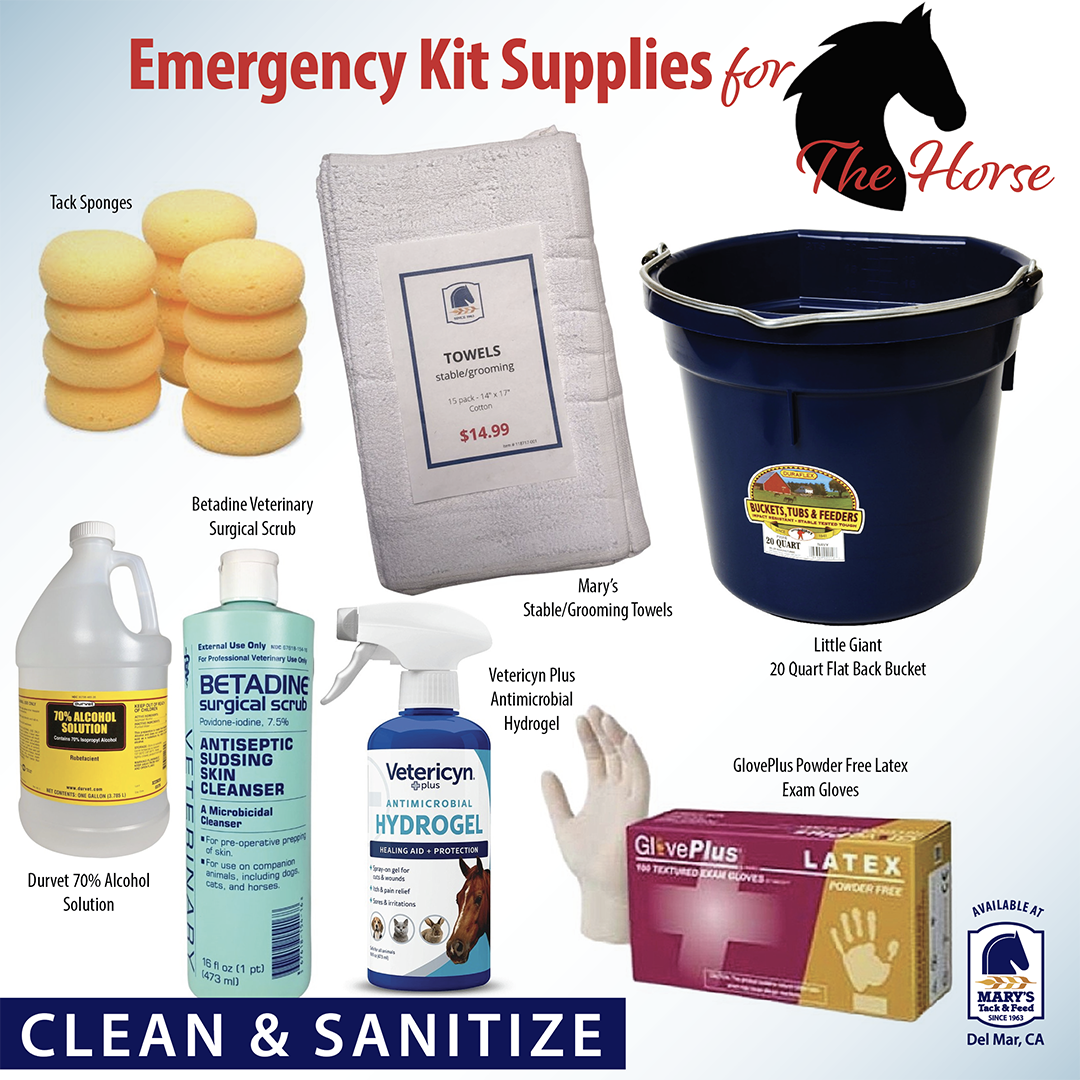 |
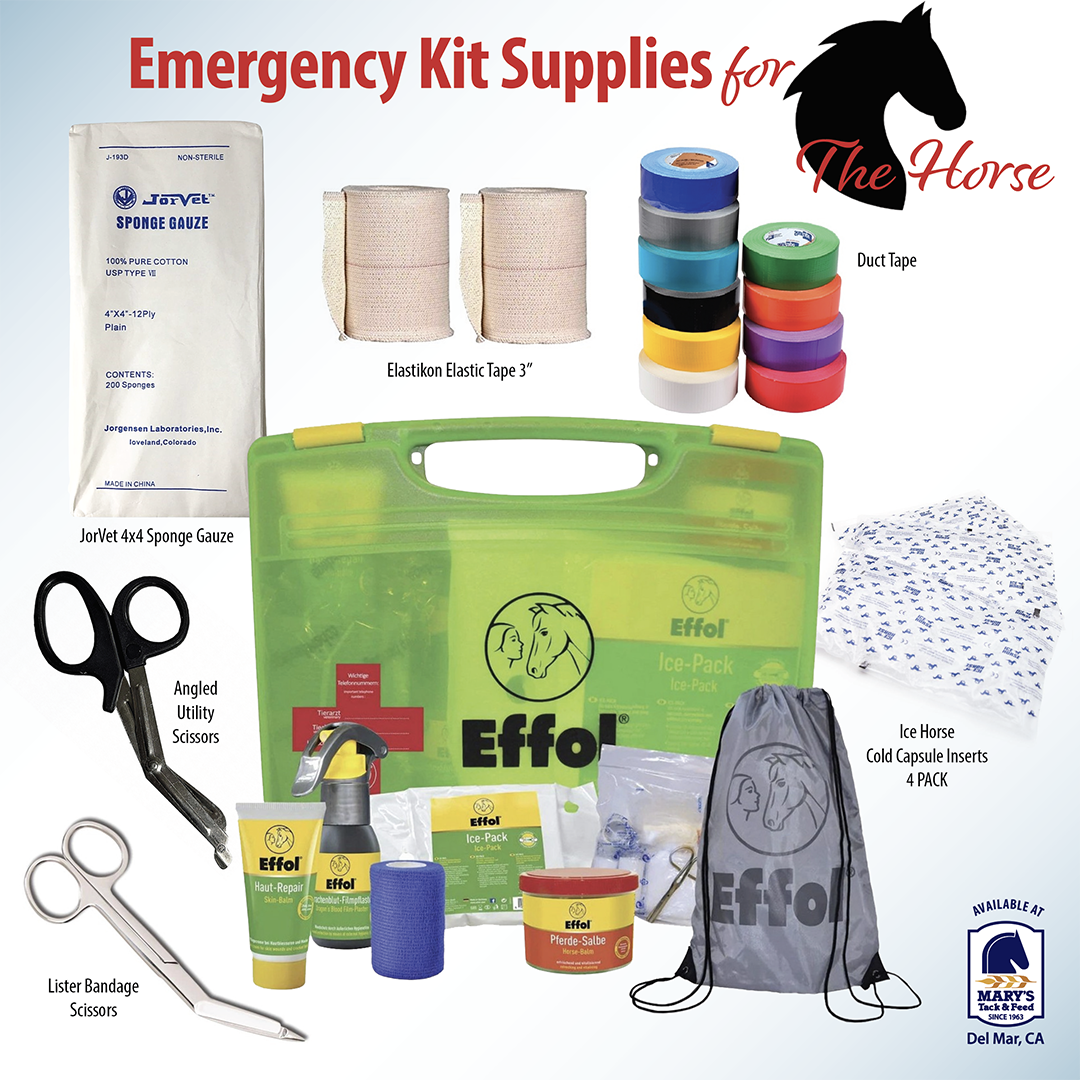 |
 |
 |
TREATING CUTS AND SCRAPES
Whether a horse gets a minor scrape or deep gash that requires veterinary attention, it’s important to keep the wound clean to prevent infection. Some good things to keep in your horse wound care arsenal are latex gloves, sponges, a clean bucket, clean towels, and equine antiseptic like Betadine or Chlorhexidine Solution. Keeping a wound clean and dry is essential to aiding the healing process. You always want to clean an open wound before applying any other ointment or treatment.
Once you have the tools you need to clean an injury, the next step is making sure you have some horse wound ointment and equine bandaging supplies to protect the wound. Equine wound dressing products such as Vetericyn, Tricare, Corona Cream, create a protective barrier between the wound and debris like dust, shavings, and bacteria. They also create an environment that makes it easier for your horse’s body to heal.
Depending on the severity of the injury, you may want to apply another outer protective layer to the wound. Horse injury care products like Alushield Liquid Bandage is a simple way to provide a waterproof barrier for a shallow wound. Mary’s also stocks gauze pads, 3M VetRap or Elastickon, bandage scissors, and veterinary tape for injuries that need to be wrapped and kept as clean as possible.
Tip: When wrapping a horse, be sure to start at the front of the leg, creating tension at the bone, and wrapping gently around the back of the leg. Be careful not to apply too much tension around the horse’s tendons.
Wounds can also attract flies, which carry bacteria and can hinder the healing process. Be sure to have fly spray such as Pyranha Wipe N’ Spray or Tri-Tec 14 and SWAT Fly Repellent Ointment on hand as well. Keep in mind that these products are irritants and should not be applied directly to the wound.
TREATING HOOVES
Hoof injuries can manifest in many different ways. Mary’s can provide resources for the occasional mishap like a thrown shoe, thrush, or a hoof abscess. Thrush is simple to treat when caught early. Clean the affected hoof or hooves with a hoof pick and apply some thrush rid, Hooflex Thrush Remedy, Koppertox, or a similar thrush treatment.
For treating abscesses or inflammation, having a hoof poultice on hand — such as Hooflex Magic Cushion Hoof Packing poultice, or Durvet Epsom Salt Poultice – is a great addition to your horse safety kit.
If you need to apply a poultice to treat any hoof inflammation, there are a few horse hoof care supplies that are essential to make sure the hoof is clean enough to effectively apply the poultice. You’ll want to have supplies to clean and soak the hoof like a clean, shallow feed pan or Hoof Soaking Container, some clean towels, and hoof bandaging supplies to pad and wrap the hoof. Other supplies would include diapers, VetRap, duct tape, and some bandage scissors.
If you are unsure about how to soak a hoof, start with following these steps:
Fill a clean, shallow feed pan or bucket with warm water. Make sure it’s not too hot to touch, as you want the waterline to go a little bit higher than the coronet band of the hoof. Pour Epsom salt into the water, about 1 cup of salt for every gallon of water. Don’t worry if you think you’ve added too much salt, Epsom salt is an excellent, gentle cleaner for hooves and will not hurt your horse.
Some horses are reactive to new or stressful situations like soaking their feet in water. If this is the case, you do not want your horse tied to anything they can’t break away from.
Have someone holding your horse on a lead rope. Speaking in a calm, reassuring way, and offering a few treats can go a long way to soothe an anxious horse. If your horse is still reactive, try using a lip chain, or a twitch. These tools can steady a horse that is nervous or unsure, and can naturally cause your horse to release endorphins, helping them stay still while their foot soaks.
Once the hoof has soaked for about 15-20 minutes, place a clean towel on the ground to prevent it from getting dirty again.
Make sure your horse’s hoof is completely dry before applying any ointment or poultice to it. Even if you can’t diagnose what is wrong with your horse’s hoof, it’s good to keep it clean and dry before the vet is able to inspect it. Products like the Rx Easy Boot are another convenient alternative to keep your horse’s hoof cushioned and clean.
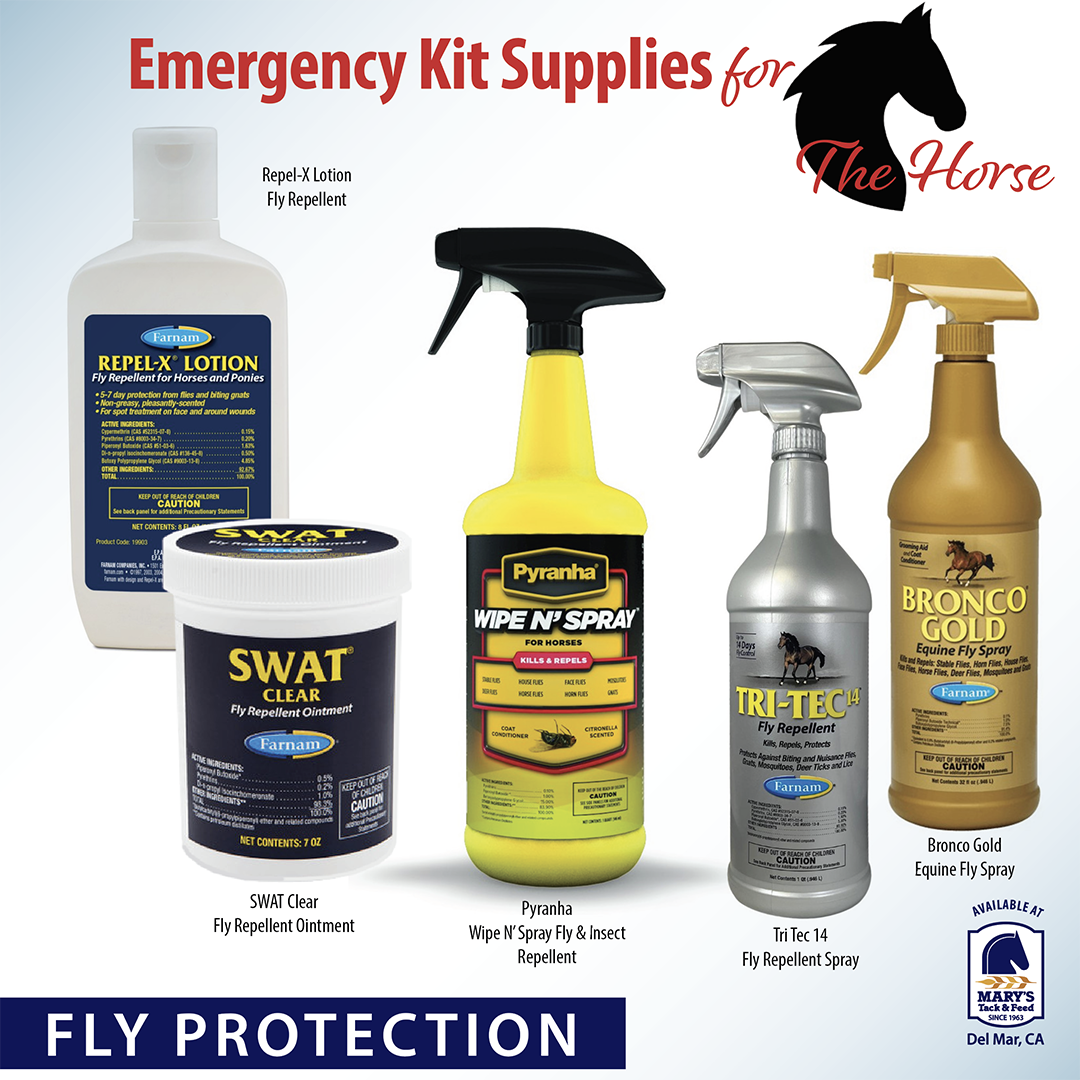 |
 |
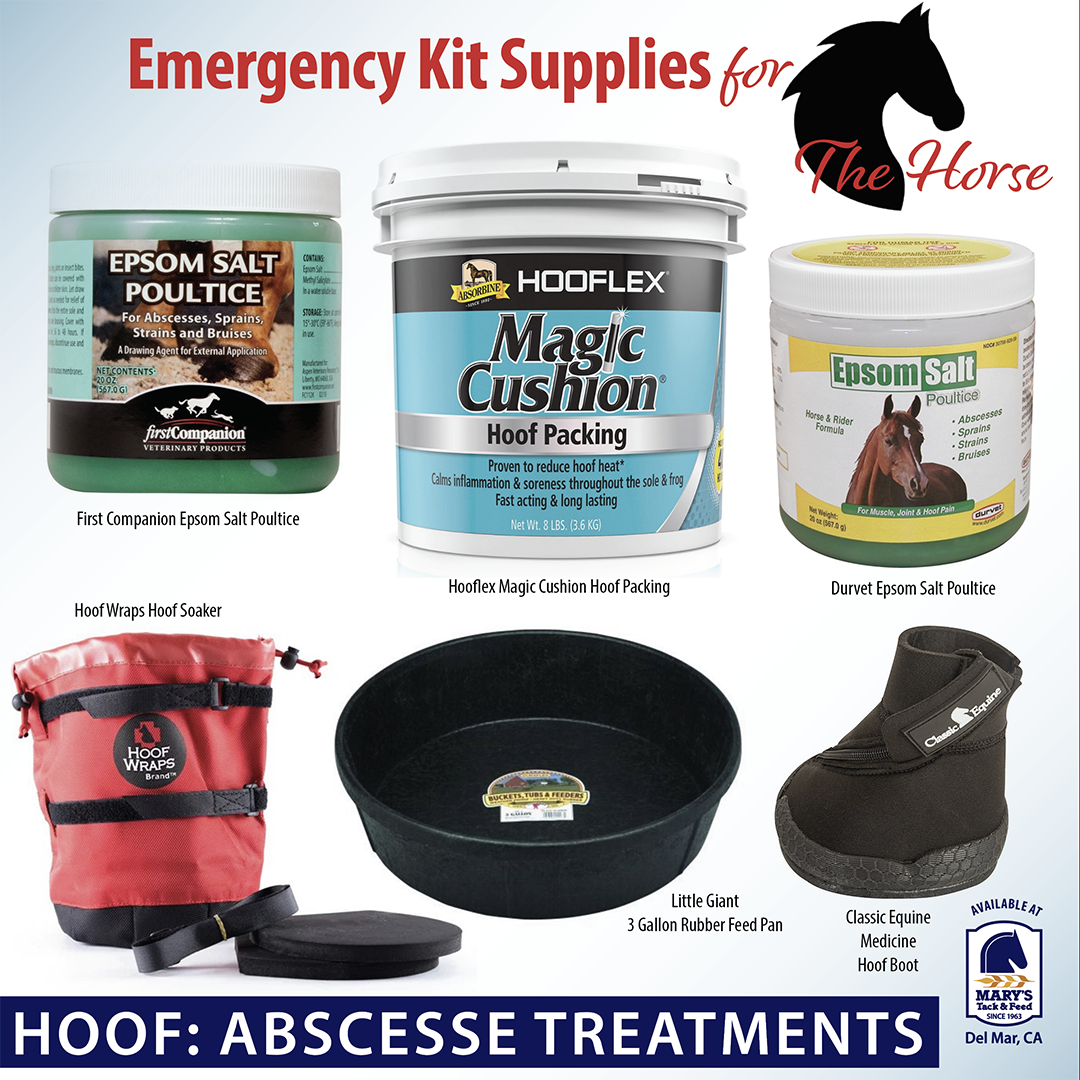 |
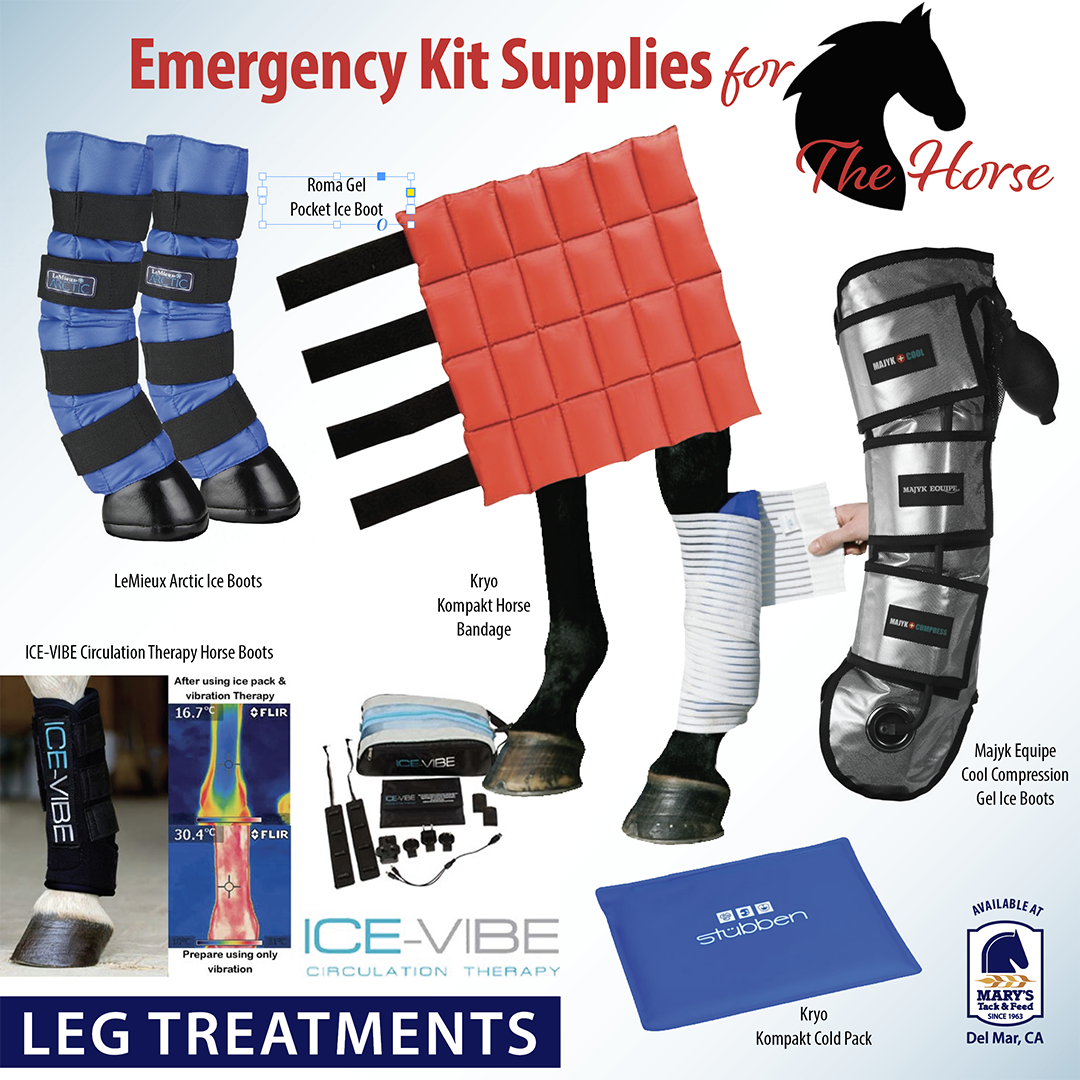 |
TREATING TENDONS
Sometimes overworking or kicking can cause inflammation in a horse’s legs. For the off day when your horse is stocked up, you’ll want some horse bandages and a few other leg treatment products to supplement your collection of horse first aid essentials.
For heat and inflammation, ice boots are a great tool to have on hand. Ice boots such as Ice Horse Tendon Wraps are a seamless way to compress and cool inflamed tendons. You can also make your own ice wraps with Polo Wraps and Ice Horse inserts or an ice pack.
Mary’s also offers an assortment of poultices, like Tenda Premium Medicated Poultice, and Durvet Epsom Salt Poultice, that can help soothe inflamed tissue.
Whether you need to apply a poultice or just apply pressure, horse leg wraps are vital for horse injury treatment. Using pillow wraps and standing wraps can both treat swollen legs and help prevent any impact damage from occurring. For example, if you are concerned about your horse being injured during transport, wrap all four legs to prevent or reduce an injury.
ILLNESS
It can be tricky to diagnose an illness without a vet’s expertise, but there are still ways to confirm that your horse may be ill. Horse health care essentials like a rectal thermometer and petroleum jelly, can help gauge your horse’s vitals. Keep in mind that a horse’s normal body temperature can range between 99- and 101-degrees Fahrenheit.
If you suspect your horse is suffering any respiratory issues, there are a few ways to tell if their normal respiration rate is altered, and the only tool you really need is a timer. A horse typically takes 8–14 breaths per minute when they aren’t exerting themselves. If you watch the rise and fall of their flank, you can count each inhale over the span of a minute. It’s okay if you count one or two more breaths than average, but if your horse’s breathing is labored when they are at rest, they may be in pain or experiencing respiratory issues. Frequent coughing, and excess mucus can also be a telltale sign that your horse’s lungs are reacting to some kind of irritant. This could range from allergies, a respiratory infection, an airway blockage, or another condition that requires a veterinary diagnosis.
It’s a good idea to keep any prescription medications in your horse medical kit. If your horse doesn’t have any prescriptions, not to worry! Mary’s offers some over-the-counter medications that can help ease any discomfort. For signs of soreness, there are horse pain relief products such as Aniprin Aspirin Powder that you can mix into a bran mash. If there are signs of digestive discomfort, such as colic Immediate Response Digestive Paste is another good emergency treatment to have on hand.
Remember to keep a copy of your vet’s phone number on hand, so you – or anyone else responsible for your horse’s health – have access to the correct emergency care physician. This is especially helpful if something happens to your horse when you are not around.
A horse emergency kit may not be able to replace a vet, but staying prepared and keeping a comprehensive collection of vet supplies can turn an emergency situation into a manageable one. Rest assured that having one around will give you peace of mind and reduce stress for both you and your horse.
See all products for Horse Health & First Aid.
Other Articles You May Enjoy:
- Emergency Preparedness for Horses
- Preparing for an Equine Emergency Evacuation Plan (with bonus sheets for First Aid Checklist)
- Tack Room and Barn Essentials
Source links:
https://esc.rutgers.edu/fact_sheet/measuring-tpr/
https://gvequine.com/how-to-soak-and-wrap-a-hoof/
https://madbarn.com/equine-heaves/?srsltid=AfmBOop88P2OeEnBl6LgyNjZABz1ZdO1N-r4JLAKRGxCA768VWl6XK7x
